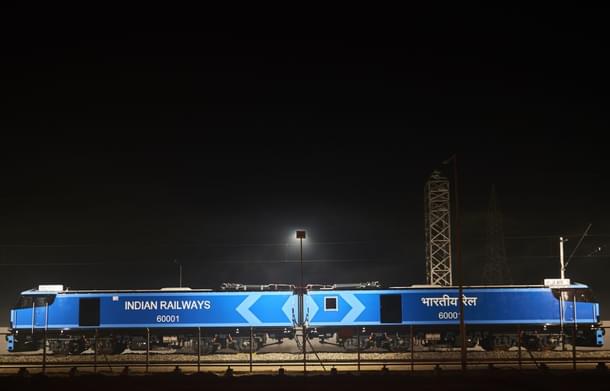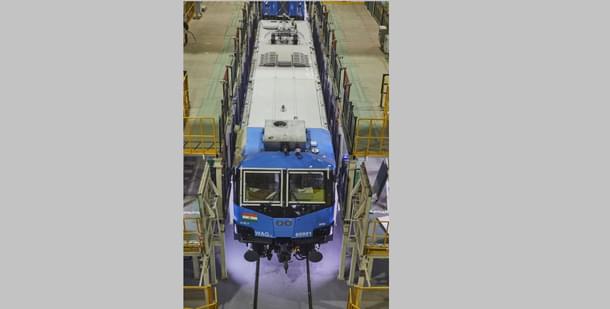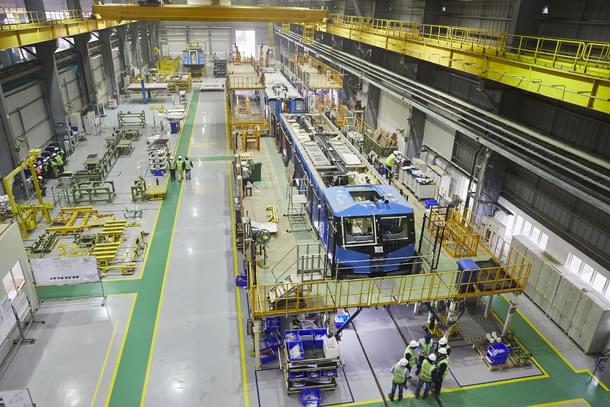Infrastructure
Madhepura’s Maiden Made-in-India Locomotive Flags Off Bihar’s Industrialisation
Aashish Chandorkar
Apr 10, 2018, 03:41 PM | Updated 03:41 PM IST
Save & read from anywhere!
Bookmark stories for easy access on any device or the Swarajya app.


The list of largest locomotives page on Wikipedia recently got a new entry in the form of an Indian locomotive class WAG-12, referring to the 12,000 horsepower locomotive from ELF Madhepura. Prime Minister Narendra Modi flagged off one of the most powerful electric locomotives in the world on 10 April.
Projects which are global best-in-class do not often materialise in India with ease, and the Electric Locomotive Factory in Madhepura is no exception.
Conceptualised in the mid-2000s, the project was approved by the Cabinet Committee of Economic Affairs (CCEA) in February 2007. The project then waited two years, before the Manmohan Singh cabinet decided to take a Joint Venture (JV) route in February 2009. The bidding process then started but was aborted after only one bid came in. Since most of the shortlisted bidders showed no interest in partnering with the Government of India at that time, the project was then decided to be implemented by Indian Railways.
The project then hit the usual capex deficiency problem - Indian Railways had no money for another departmental manufacturing plant. The ministry, along with the Planning Commission, went back to the cabinet to revert the implementation plan to a JV. It took another year for the cabinet to approve this, and in February 2010, the plan was back to square one, three years after project approval. Fresh bid documents were issued in October 2010, but with the customary policy paralysis which marred the United Progressive Alliance (UPA) 2 government, the process stalled.
Prime minister (PM) Manmohan Singh then constituted a group of ministers (GOM) to resolve this - his favourite policy decision vehicle. The GOM decided to go for fresh bids in April 2013 and this proposal was accepted by the cabinet in May 2013. The bid document took another few months to prepare and was approved by the cabinet only in Jan 2014.
In May 2014, the Narendra Modi government took over. It inherited this legacy project, which had now taken seven years to go from the first approval to creating a bid document. The bid process progressed and finally, an award came through in November 2015 - Alstom was the chosen partner. Ironically for the government, this approval for the largest “Make In India” project in Bihar came a day after the Bharatiya Janata Party (BJP) lost the state elections to an alliance spearheaded by Lalu Prasad Yadav of the Rashtriya Janata Dal (RJD). Madhepura was Lalu's home turf, and as the minister for railways from May 2004 to May 2009, he had presided over the initial project delay.

Alstom (76 per cent) and the Ministry of Railways (24 per cent) set up a JV Madhepura Electric Locomotive Private Limited (MELPL), which signed the contract agreement to produce these locomotives on 30 November 2015. The land lease agreement was signed soon after in March 2016. About two years later, the first phase of the factory is completed and the first freight locomotive has now been flagged off. The locomotive made its way to Saharanpur for the next phase of testing before it starts operating for Indian Railways.
The Madhepura Electric Locomotive Factory is a Euro 3.5 billion project. It is one of the largest foreign direct investments in India. As the first tract of the Western Dedicated Freight Corridor (DFC) opens for initial tests, the WAG-12 will overhaul the speed at which freight moves. The two DFCs - Western and Eastern should complete over the next two to three years, and will then fully tap into the power of this Alstom locomotive. The locomotive is designed to haul up to 6,000 tonnes at a peak speed of 120 kilometres per hour.

The Alstom JV is set up as a manufacturing plus maintenance contract. The two maintenance facilities for its locomotives will be set up at Saharanpur in Uttar Pradesh and Nagpur in Maharashtra. Alstom will maintain its locomotives for the next 11 years. In all, the Madhepura factory will roll out 800 “Made In India” locomotives, which will also help Indian Railways fast track its electrification program. These three projects will eventually create up to 12,000 direct and indirect jobs, benefitting Bihar and Uttar Pradesh - the two states which need to play an economic catch-up with other large states.

Coinciding with the increasing pace of the DFC testing, the Madhepura factory will roll out three more locomotives in 2018 for Railways to test. Indian Railways expects to induct the first locomotive flagged off by PM Modi by end of this year after all testing is completed.
As the Indian Railways order of 800 locomotives is fulfilled, the Madhepura facility can also focus on exports - India has lately taken renewed interest in using Railways know-how to help friendly countries like Myanmar and the United Arab Emirates.
By the end of 2018, Bihar would have become the hub of modern locomotive production - the General Electric (GE) Brilliant Factory to manufacture diesel locomotives is currently taking shape in Marhowra, about 300 kilometres west of Madhepura. The $2.5 billion GE investment is to supply 1,000 diesel locomotives to the Indian Railways - 40 of these will be imported and the rest 960 manufactured locally. The first GE locomotive was handed over to the Railway for testing in October 2017.
Bihar and eastern India in general, is finally getting a welcome taste of high profile, global standards industrialisation.
Aashish Chandorkar is Counsellor at the Permanent Mission of India to the World Trade Organization in Geneva. He took up this role in September 2021. He writes on public policy in his personal capacity.





